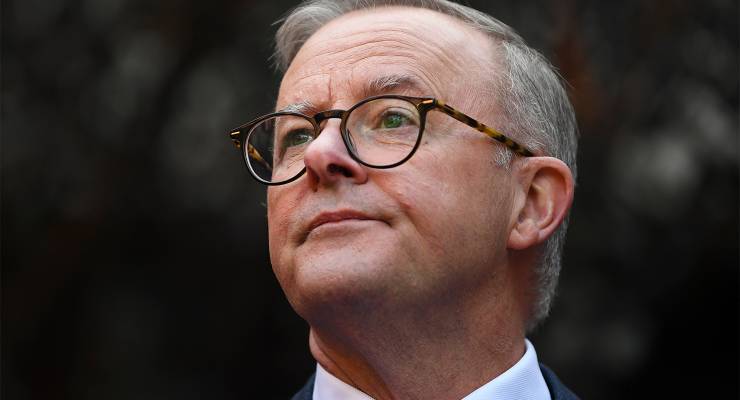
A year ago Anthony Albanese was out and about, lecturing Australia’s incumbent prime minister. Scott Morrison needs to get out, go to medical centres and find out what’s happening, he said.
“People are having their vaccine appointments cancelled, and there is a national shortage of rapid tests because he didn’t order enough,” said the Labor leader. It was all part of Albanese’s grand plan, that “kick with the wind in the final quarter” thing that’s now part of Australian political folklore.
Whether it was carefully calculated genius or the usual mix of perspiration and plain luck, we can argue for as long as the pubs and cafes are open.
It was, at least in hindsight, a brilliant start to one of the better years the Australian Labor Party has had in the past quarter century. Pretty well everything went right and even the spectacular disasters — day one on the campaign trail anyone? — were mere speed bumps. Labor was in better shape and Albanese ultimately saw Morrison and his clown car government off the national stage.
The emergence of a majority Labor government was bad enough for the conservative side of politics, but this humiliation was worsened by the running of the electoral boards by the Greens, which picked up three new seats from the inner-urban ring in Brisbane, and a new insurgent crowd: centrist, female independents tagged as “teals”.
The most enduring jewels in conservative crowns and tiaras like Kooyong in Melbourne, Wentworth and North Sydney in New South Wales, and Curtin in Perth were dragged across from the Liberal column to independent. Now, it’s year two. Labor has had eight months in office, having made the most of it in every way. Albanese and his ministry of the competent and coherent have wasted little time. They’ve methodically, properly and — for modern Australia — uncharacteristically gone about the business of doing what they’d said they would.
Election commitments have been fulfilled and promises met. Any voters paying attention have been shocked. Those glancing casually are pleased.
No wonder Labor and the new prime minister ended the year on top in the polls with a rise of five to six points since the election (a preferred vote of 57% and a primary share of just under 39%).
Albanese has a net satisfaction rating of plus 32% while the LNP’s Peter Dutton is minus 10%. They are 68% apart in the preferred prime minister stakes.
Making good on those election pledges is critical in rebuilding trust after more than a decade of unfulfilled expectations, broken promises, lies and deceit, but the creation of an agenda for the future is just as vital.
Albanese, his treasurer Jim Chalmers, the rest of the leadership team, his campaign boss Paul Erickson and personal office consigliere Tim Gartrell know that whenever the next election rolls around, voters will pay on what’s been done for them lately, not on fulfilling two-year-old pledges and preventing disasters.
This is why Albanese and Chalmers — shaping up as the most formidable prime minister and treasurer team since John Howard and Peter Costello — will have to craft a big agenda for 2023.
There are plenty of opportunities that can be distilled into two-time blocks.
First, the build-up to the 2023 budget in May. The government is going to have a shelf-load of reports handed to it in the months leading up to and after the budget. It began last week with the latest numbers on our population illustrating a workforce challenge — something that’s going to be brought into sharper focus next month when the Productivity Commission lays down an analysis of the future of work.
Chalmers is uniquely suited to step up on this front. More than five years ago he wrote, with former NBN boss Mike Quigley, Changing Jobs: The Fair Go in the New Machine Age, an often overlooked book. The pair wanted a conversation about one of the biggest policy, societal and political challenges on the table in those quiet days of 2017 (although myriad, evolving, constantly moving targets have since rendered that challenge to just another item on the to-do list).
If Chalmers has the courage to follow through with some of the ingredients he’s been tossing into his own future-of-work gumbo over the years, we could have a substantial plan for where the country goes in a workplace world put into a higher gear by COVID-19.
Down the corridor, Climate Change Minister Chris Bowen is rolling out a few consequential reports in his wheelhouse, including former ANU professor Ian Chubb’s much-anticipated review of the integrity of the Emission Reduction Fund’s carbon credit guidelines. There will be a concerted effort to give the current emissions safeguards policy some teeth (it’s likely this will evolve into what’s effectively an emissions-intensity emissions trading scheme).
Beyond these high-calorie policy helpings, others are just as rich. In March, the future of the Reserve Bank will be on the table, at about the same time Defence Minister Richard Marles will have a roadmap for where we go on the next generation of submarines and the broader, comprehensive defence strategic review.
Any one of these has the makings of an agenda-setting way ahead, one built on whatever’s in the May budget. They also provide a context for the next chapter in the Albanese story. There are plenty of “what about” corners of public policy demanding attention, and these will be worth attending to after the budget in the lead-up to Labor’s other significant event of the year: its national conference in Brisbane in August. This is hard stuff with some hard choices to be made. But in these opportunities lies the kind of agenda Bob Hawke and Paul Keating shaped 40 years ago.
Medicare is in crisis and needs national leadership to bring it back from the abyss. Funding for the National Disability Insurance Scheme (NDIS) is also under siege, and there’s a housing crisis that’s getting worse by the day. New natural disasters not only expose the fragility of our environment in these times of change but also point to an insurance market that’s at breaking point.
If Albanese and Chalmers can’t make something of all this — and a few other peripheral challenges — they are, to paraphrase Keating, just camping out.
Albanese, as seeped in Labor history as any leader and prime minister for half a century, will have a chance to shine when he presides over the conference. He understands the visceral passion Keating described when he talked about the Labor Party decades ago, particularly regarding what it means to be in the federal caucus.
“That dash across the political heaven, going after the things that matter, that get the heart beating faster, that make it all worthwhile,” said Keating.
“And, of course, of being there — at the centre of the action.”
That’s where Albanese sees himself. We’ll see in seven months whether he makes it.








There are a lot of bleeding wounds that Labor needs to stitch up, but housing is the most critical. The nation can survive the worst mismanagement and grift (it already has, under the Coalition), but it can’t survive if a large part of its population is homeless or in the sort of slums and ghettoes that breed resentment, crime and a desire to lash out at whoever is seen as responsible.
There’s not a housing shortage, but there sure is a housing distribution problem. So many empty houses… far more than the people living on the streets and on couches. Is the government going to do something about that, or are they going to continue to expand our cities and wiping out native habitat to build suburbs not fit for purpose and too far away from jobs?
Not to mention that arable land (on the fringes of the environs of those cities, with the ‘dependable’ water supply, and soils, that made their original establishment in those areas so attractive) being diverted from such agricultural productivity, instead buried away, under little boxes, tar and cement.
One million homes were empty on census night! Release of these homes onto the rental or home market could solve a lot of the home shortage.
Empty tax , anyone?
Will they help to pay for this stuff by dumping the Stage 3 tax cuts, which were of course also an “electoral promise”?
If they have any real commitment to delivering the rest then they must go. They were unafordable when Morriscum pushed them through and are even less so now.
“will be a concerted effort to give … some teeth … likely this will evolve into what’s effectively an [emissions-permissive] trading scheme”. This is much too slow!
With the Teals temporarily available, the government currently has the chance to declare a date for the extinction of all gas extraction, with milestones to be met between now and then. Similarly to declare CO2 as a pollutant, so that polluters can be prosecuted. Activists should be embarking on public mock trials of fossil fuel leaders and their shareholders to test out the legislation and how to prosecute it.
Did you miss all the clues pointing to the presence of Labor in big fossil fuel’s pocket?
“A Labor Prime Minister’s year ahead – by an ex-Mudroch Curry or Maul Coalition PR tout”?
… Did he show up to do the same for Morrison’s ‘year ahead’?
[In a trail of so many paid habitual pro-Coalition snow jobs, a dissertation on ‘what went wrong in the Middle East’ : leaving out that bit about the invasion of Iraq by the Coalition of the Willing (with an embedded Mudroch, on PR). “Suffice” a one line reference to “the invasion of Iraq by the US”?]
Is Crikey where some such come to be “unremembered”, rebranded and resold?
“…. based in Brisbane where he was a national political editor during the Howard government” for what ‘organisation/doing what’? Those years beavering away in Mudroch’s Curry or Maul selling the Howard government to the general voting public?
… There. Was that so hard?
….. Would full disclosure really be so ’embarrassing’?
King’s another.
If our viewsmedia’s history/form is so “unimportant” (that it can be ignored) : why isn’t everyone else’s?
Jan 13 – today’s edition of Menadue’s ‘Pearls and Irritations’ – the piece by Caitlin Johnstone – re the protection racket run by the sycophant media (craving the acceptance of the rest of in-crowd media herd) for their media cohort : rather than bringing to attention the failures of that media?
Crikey will at various times rail against the abuse of position of Mudroch’s media empire. But when putsch comes to shove, they’ll take on those Mudroch minions that were employed doing what Crikey rails against????
No wonder Labor and the new prime minister ended the year on top in the polls with a rise of five to six points since the election (a preferred vote of 57% and a primary share of just under 39%).
I find those stats interesting, though not surprising. I wonder if the seeming difference between May and December numbers is not partly explained by what has been termed “strategic voting” in the May elections. ALP voters, recognising that their candidates would/could not win certain seats, voted instead for independents so that sitting Libs were ousted. The outcomes in all the teal-won seats plus Pocock’s Senate place, all resulted from such voting.
But when surveyed in December maybe those stategic voters reverted to their usual response rather then reflecting on where their vote went in May?